Pharmacological Effects
Pharmacological effects of NooTune products:
CHOLINOMIMETIC – increasing attention and concentration, improving the ability to memorize and reproduce, slight psychoenergizing effect, increasing the speed of reaction to visual and motor stimuli
ANALEPTIC – awakening reaction, decreasing the feeling of cognitive fatigue
ADAPTOGEN – increased resistance to stress, calmness, balance and increased ability to ignore/minimize the effects of disruptive stimuli
NEUROMETABOLIC – supports prolonged cognitive effort, reduced psychoenergizing effect
OTHER EFFECTS – anti-inflammatory, including at the cerebral level; antioxidant; cardiovascular protection
Citicoline
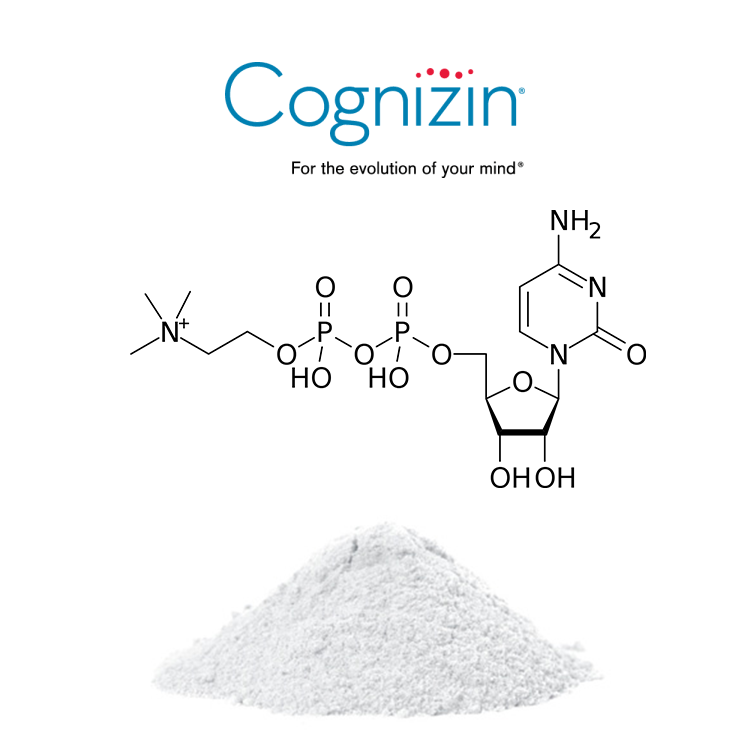
Image source: https://pubchem.ncbi.nlm.nih.gov
Phospholipids are key elements of cell membranes and due to their high turnover rate, a permanent synthesis is required to maintain cellular functions.
Citicoline is a substance also found in nature that serves as a precursor for the synthesis of the neurotransmitter acetylcholine. Cholinergic neurons in the central nervous system are involved in the regulation of higher functions such as attention, learning, thinking. Citicoline also has other metabolic roles, being involved in the synthesis of DNA and RNA, some components of cell membranes.
Medical Nootropics products use pharmaceutical grade and highest quality citicoline produced by the Japanese company Kyowa Hakko Bio Co, LDT. under the Cognizin brand.
Citicoline is the generic name for cytidine-5′-diphosphocholine (CDP-choline), a pharmacological substance chemically similar to the natural intracellular precursor of the phospholipid phosphatidyl-choline. CDP-choline is a mononucleotide composed of ribose, cytosine, pyrophosphate and choline with the chemical formula 2-oxy-4-aminopyrimidine. The CDP-choline cycle is part of a wider metabolic network, and its disruption may impact the distribution of lipid-bound metabolites in other pathways. CDP-choline is also involved in the metabolism of acetylcholine, and taking CDP-choline provides an additional source of choline and cytidine. Choline is a precursor and metabolite of acetylcholine, participates in one-carbon metabolism and is a component of several membrane phospholipids. Once converted to uridine, the cytidine moiety is used for DNA and RNA synthesis, as well as for the production of membrane components and glycosylation, and has a crucial influence on purinergic receptors.
Citicoline improves brain metabolism and has neuroprotective properties in animals and humans. Citicoline improves cognitive deficits found in various conditions, including vascular and degenerative dementias, cerebrovascular diseases, amyotrophic lateral sclerosis, Alzheimer’s disease, and Parkinson’s disease.
Citicoline has a very good safety profile.
Lecitine

Image Source: https://www.efia.cz/blog/lecitin-jako-vsestranny-revitalizer-pro-telo-i-mysl
Lecithin is a phospholipid found in the composition of all cellular and intracellular membranes in the body, playing an essential role in maintaining the integrity and proper functioning of cells. In a higher concentration, lecithins and their derivatives are found in organs such as the brain, liver, heart, kidneys. Lecithin also plays a role in the formation of neurotransmitters, especially acetylcholine.
In periods of intense physical and mental effort, stress, convalescence, the need for lecithin is higher, and supplementation from an external source is necessary, soya lecithin being the most frequently used source in the pharmaceutical industry. Supplements containing lecithin can also be consumed by healthy young or senior people.
Lecithin is a mixture of choline, choline esters, fatty acids, glycerol, glycolipids, triglycerides, phosphoric acid, and phospholipids such as phosphatidylcholine. The most important bioactive compound of lecithin is phosphatidyl-choline, the most common phospholipid in cellular and intracellular membranes in mammals (58%), as well as the most abundant phospholipid in cell plasma. The absence of choline sources or the severe disruption of its metabolism causes impairment of cellular functions and finally apoptosis.
Choline plays a prominent role in the synthesis of various membrane phospholipids and is essential for cholinergic neurons by contributing to the synthesis of acetylcholine. Lecithin modulates various pathways of intercellular communication and pathophysiological processes, is necessary for the synthesis of phosphatidylcholine, lyso-phosphatidylcholine, sphingomyelin and plasmalogen, as well as other phospholipids. It has a well-established involvement in neurogenesis and memory development, and its absence during pregnancy can cause neural tube abnormalities.
Lecithin easily crosses the blood-brain barrier (BBB). It acts through two separate mechanisms of action. Precursors are first used as a substrate for the synthesis of acetylcholine, which can enhance cholinergic neurotransmission. It also has a strong neuro-protective effect and plays an essential role in the formation of new nerve cells (neurogenesis).
Magnesium Citrate

Image Source: https://5.imimg.com/
Magnesium is an important mineral with a multitude of roles in the human body, including serving as a co-factor in over 300 enzymatic reactions. Magnesium is essential for the regulation of muscle contraction (including myocardial), blood pressure, insulin metabolism, and is required for DNA, RNA and protein synthesis. At the level of the nervous system, magnesium plays an essential role in ensuring the transmission of nerve impulses and neuromuscular coordination, as well as in the protection against excitotoxicity (excessive excitation leading to the apoptosis of nerve cells). There is more research that points to the neuroprotective role of magnesium for patients suffering from migraines and depression, and possibly also for patients with chronic pain, anxiety disorder, or stroke sequelae. For example, magnesium administration attenuated neurobehavioral and pathological changes in animal models of brain injury.
Magnesium in ionic form plays an important role in the human body, being involved in numerous enzymatic reactions, being essential for achieving muscle contractions, including the heart muscle. Magnesium is also involved in the regulation of blood pressure, carbohydrate metabolism and is necessary for the synthesis of nucleic acids and proteins.
At the level of the nervous system, magnesium is involved in the transmission of nerve impulses, maintaining the health of neurons and blood vessels in the brain. Magnesium supplements are recommended as an adjunct to patients suffering from migraines, anxiety-depressive disorders, and cerebrovascular diseases.
Magnesium citrate represents a form with increased bioavailability, allowing rapid absorption in the digestive tract and without side effects in the recommended doses.
Magnesium deficiency is associated with increased oxidative stress through a reduction in plasma antioxidants and increased lipid peroxidation, possibly due to increased susceptibility of tissues to oxidative stress. Brain magnesium deficiency is associated with a more intense degree of neuro-inflammation and neuro-degeneration, especially through the overexpression of some genes associated with neuro-inflammation in the hippocampus and cortex.
Magnesium citrate has increased bioavailability and a high safety profile.
In large doses, magnesium citrate can have a laxative effect.
Vitamin B6
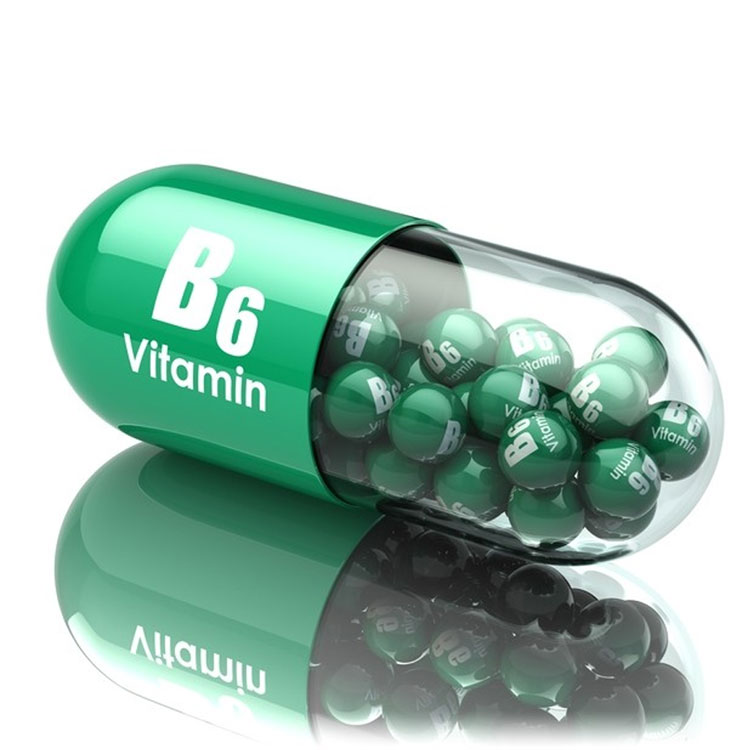
Image Source: https://www.nutraingredients-asia.com/
Vitamin B6 plays an essential role in the body, being involved in over 160 enzymatic reactions. It is a water-soluble vitamin essential for the proper functioning of the nervous system, the cardiovascular system, the formation of hemoglobin, in the metabolism of carbohydrates, maintaining the health of muscles and skin. The absence of vitamin B6 in the diet is associated with severe neurological and behavioral disorders.
The need for vitamin B6 increases during periods of long concentration, psychological stress, physical exertion.
It is important that vitamin B6 is administered in optimal doses, as abuse can generate unwanted side effects.
Vitamin B6 chemically comprises a group of six water-soluble chemical compounds: pyridoxal (PL), pyridoxamine (PM), pyridoxine (PN) and their 5′-phosphates.
The active form, which is pyridoxal phosphate (PLP), serves as a co-factor for approximately 160 biological reactions in the body. Vitamin B6 participates in the transformation of carbohydrates, lipids, amino acids and nucleic acids and is involved in the control of processes such as blood pressure regulation and blood coagulation, ensuring the integrity of the endothelium and the aggregation of platelets. The WHO recommended daily intake of vitamin B6 for adults is 1.3-1.7 mg per day.
Vitamin B6 is required for the biosynthesis of several neurotransmitters such as serotonin, dopamine and γ-aminobutyric acid (GABA). Serotonin is involved in the regulation of appetite, sleep or cognitive functions and modulates emotional state. In comparison, dopamine influences the activity of the sympathetic nervous system, where it is involved in the regulation of blood pressure and heart rate, while GABA is a major inhibitory neurotransmitter that broadly controls the excitability of neurons.
Lack of pyridoxine can cause anemia, neurological damage, seizures, behavioral disorders, dermatological problems. Deficiency, although rare due to widespread distribution in food, can cause peripheral neuritis in adults and affects the central nervous system in children.
Rhodiola Rosea Root Extract
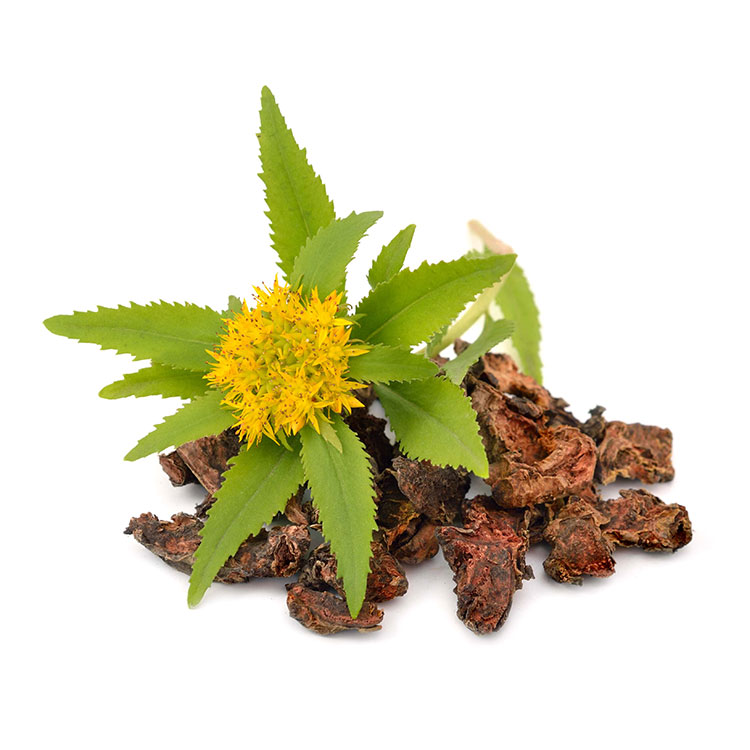
Image Source: https://www.nutraingredients-asia.com/
Rhodiola Rosea is a perennial plant found in cold areas, such as the Arctic, the mountains of Central Asia, North America, Europe. It has been used in traditional medicine since ancient times and in some areas of the world parts of the plant are consumed as food.
The standardized extract of Rhodiola Rosea is considered to have adaptogenic properties, allowing adaptation to prolonged or intense physical and psychological stress. Its compounds intervene in the secretion of the neurotransmitters serotonin and dopamine, at a metabolic level and possibly at a hormonal level.
A recognized effect of the standardized extract of Rhodiola rosea is that of reducing anxiety and promoting a state of inner calm and balance.
Rhodiola rosea L., popularly known as “golden root”, belongs to the plant family Crassulaceae. It is a phyto-adaptogen credited with antioxidant, antidiabetic, anti-aging, cardioprotective and neuroprotective effects. Pharmaceutical research has identified more than 140 compounds isolated from Rhodiola species, including flavones, coumarins, volatiles, anthraquinone, and organic acids. Salidrosides are present in all species of the Rhodiola genus, while rosavins (rosavin, rosin, rosarin) are specific compounds found only in Rhodiola rosea L.
Standardized extracts of Rhodiola rosea L. are used as adjuvants in the therapy of Alzheimer’s disease, cardiovascular diseases, cognitive dysfunctions or recovery after cerebrovascular accidents.
The neuroprotective effects are mostly due to antioxidant, mitochondrial protective and anti-inflammatory activity. The antioxidant properties consist of reducing the levels of reactive oxygen and nitrogen species (ROS and RNS respectively), increasing the activity of superoxide dismutase (SOD), glutathione (GSH), glutathione peroxidase (GSH-Px) and catalase (CAT), shock proteins thermal 70 (HSP70), heme-oxygenase-1 (HO-1) and thioredoxin levels, which result in decreased lipid peroxidation and inhibition of lipoxygenase (LPX).
Several clinical studies demonstrate that repeated administration of R. rosea extract exerts an effect against physical and cognitive fatigue and increases mental performance (especially the ability to concentrate in healthy subjects). The lack of interaction with other drugs and adverse effects during clinical trials confirms the safety profile of standardized extracts of Rhodiola rosea L.
Extract from the body of the mushroom Hericium Erinaceus (Lion's Mane)
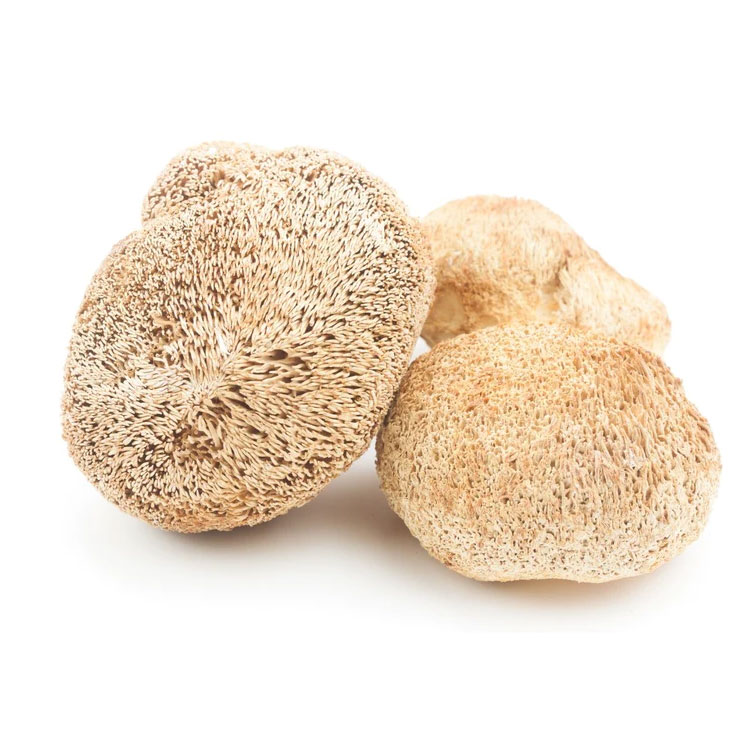
Image Source: https://www.forij.co/
Hericium erinaceus is a medicinal mushroom found in East Asian countries and is also known as the “lion’s mane” mushroom or Yamabushitake. Bioactive compounds extracted from the mushroom body or mycelium possess antioxidant, anticancer, anti-inflammatory, antimicrobial, blood sugar-maintaining and blood fat-lowering properties. Moreover, H. erinaceus is used as a supplement in the therapies of memory disorders, recovery from ischemic stroke and decreased hearing acuity.
The standardized extract of Hericium erinaceus is used as an adjuvant in the therapy of neurodegenerative diseases (Alzheimer’s, Parkinson’s), vascular and metabolic pathologies (diabetes, dyslipidemias). It is also considered to have antiolytic, psychological relaxation and emotional state modulation effects.
Hericium erinaceus is a medicinal mushroom found in East Asian countries and is commonly known as the “lion’s mane” mushroom or Yamabushitake. The bioactive compounds extracted from the mushroom body or mycelium possess antioxidant, anticancer, anti-inflammatory, antimicrobial, antihyperglycemic and hypolipidemic properties. Furthermore, H. erinaceus is used as an adjuvant in the therapies of cognitive disorders, Alzheimer’s disease, Parkinson’s disease, recovery from ischemic stroke and presbycusis.
The main bioactive compounds are erinacins and hericenones. Although erinacins were originally isolated from the mycelium of H. erinaceus, erinacins A and B can also be found in the body of the mushroom. Erinacins belong to a group of chiatin diterpenoids and have been shown to induce synthesis of the growth factor NGF.
Long-term treatment with standardized H. erinaceus extract stimulates hippocampal neurogenesis and increases survival of new neurons in the dentate gyrus. H. erinaceus extracts were found to increase both NGF mRNA and protein expression in the hippocampus, indicating that the bioactive compounds in H. erinaceus extract could cross the blood-brain barrier.
Long-term administration of H. erinaceus extract at high doses (400 mg/kg) effectively restored the expression levels of serotonin, norepinephrine, and dopamine in the hippocampus of stressed animals.
The extract from the body of the Hericius Erinaceus mushroom is also attributed adaptogenic and antidepressant properties, supporting intellectual activity.
Bacopa Monnieri leaf extract

Image Source: https://www.gardenia.net/
Bacopa monnieri (water hyssop or Brahmi in Ayurvedic medicine) is a climbing perennial plant found on all continents. It has been used in traditional medicine for millennia to support intellectual effort and emotional balance.
The main active compounds in the standardized extract of Bacopa Monnieri are bacosides, which are considered to have antioxidant, anti-inflammatory, anxiety-reducing effects and, in the case of chronic administration (several weeks), to support cognitive functions.
In the recommended doses, no significant side effects were recorded.
The major active constituents with a biological role are triterpenoid saponins called bacosides. Bacoside A, the most important fraction, is composed of four constituents: bacoside A3, bacopaside ÎI, the jujubogenin isomer of bacopasaponin C, and bacopasaponin C.
The molecular basis of the neuroprotective activity of bacosides is attributed to the regulation of mRNA translation and surface expression of neuroreceptors such as AMPAR, NMDAR and GABAR in different parts of the brain. In addition, bacosides prevent Aß aggregation and fibril formation and protect neurons against Aß-induced toxicity.
Administration of B monnieri inhibited the effects of free radicals especially in the hippocampus, prefrontal cortex and striatum areas of the brain. Pro-inflammatory cytokines (interleukin-1β and tumor necrosis factor-α), total nitrite content and lipofuscin in the cortex were significantly reduced, while nitric oxide synthase (iNOS) expression was increased. Bacopaside I showed a neuroprotective effect by reducing neurological deficits, cerebral infarct volume and edema associated with cerebral ischemia lesions in experimental animals. Oral treatment with bacopazid I significantly increased brain ATP content, antioxidant enzymes, Na+K+ATPase and Ca2+Mg2+ATPase activity.
In addition to the adaptogenic effect, B monnieri also showed an effect of reducing physical and cognitive fatigue in experimental animals that exerted maximal effort.
L-Theanine extracted from green tea leaves
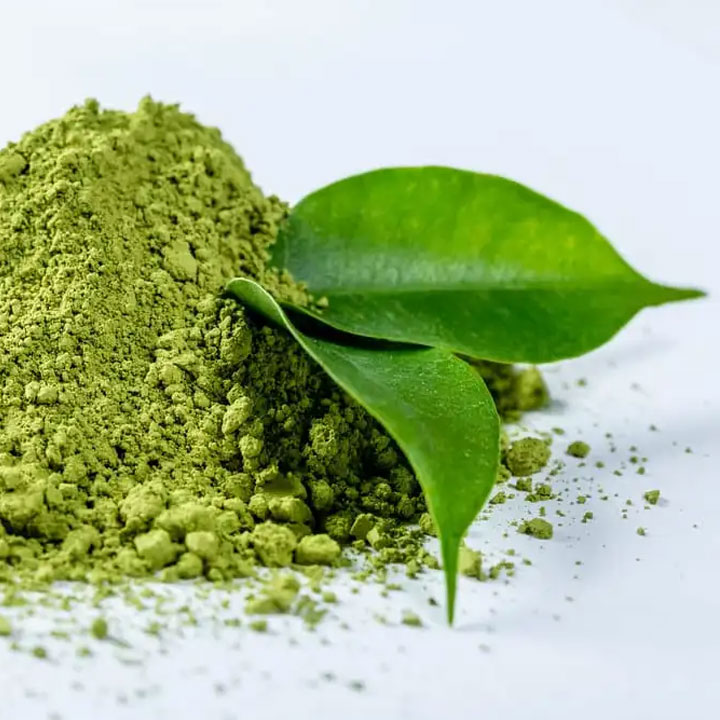
Image Source: https://www.gowinglife.com/
L-theanine is a non-essential amino acid with a structure similar to the amino acid glutamine, extracted for food and pharmaceutical consumption mainly from green, black tea and some mushrooms. Glutamine is an abundant amino acid in muscle mass and also contributes to the production of the excitatory neurotransmitter glutamate. L-theanine has affinity for glutamate-ergine receptors in the brain, but causes antagonistic, inhibitory effects. This effect promotes a state of mental relaxation, calm, balance.
L-theanine supports intellectual effort and facilitates learning by increasing the degree of attention and emotional balance, the ability to ignore disturbing stimuli. The combination of L-theanine and caffeine works synergistically to combat cognitive fatigue.
L-theanine is an amino acid found especially in green tea, black tea and some mushrooms. L-theanine is a bioactive compound with antioxidant, anti-inflammatory, neuroprotective, anticancer, metabolic regulation, cardiovascular protection, liver and kidney protection, immune regulation and anti-obesity effects. L-theanine has several mechanisms of action. It is an inhibitor of the reuptake of the neurotransmitter glutamate and, in the hippocampus, it is a competitive antagonist of low-affinity glutamate receptors. It also has a neuroprotective effect by acting on gamma aminobutyric acid (GABA)-A receptors.
At the brain level, L-theanine demonstrated antioxidant effects by adjusting non-enzymatic activities, improving catalase (CAT) mRNA activities and expression, increasing superoxide dismutase (SOD) and glutathione peroxidase 1 (Gpx1). L-theanine likely inhibits the nuclear factor kappa B (NF-κB) pathway, thus reducing the expression of pro-inflammatory factors, including cyclooxygenase-2 (COX-2), prostaglandin E2, nitric oxide, free radicals, thus protecting the degradation of the extracellular matrix. L-theanine intervenes in the regulation of glucose, lipid and protein metabolism.
L-theanine has shown a good neuroprotective effect in the case of cognitive impairments and memory disorders, and is used as an adjuvant in the therapy of neurocognitive diseases. In long-term use, it also has an antidepressant effect.
Several studies have highlighted the synergistic action of combining L-theanine and caffeine in combating cognitive fatigue and supporting attention by influencing several neurotransmitters, including dopamine, serotonin, glutamate and GABA.
L-theanine supports intellectual effort and facilitates learning by increasing the degree of attention and emotional balance, the ability to ignore disturbing stimuli. The combination of L-theanine and caffeine works synergistically to combat cognitive fatigue.
L-theanine is an amino acid found especially in green tea, black tea and some mushrooms. L-theanine is a bioactive compound with antioxidant, anti-inflammatory, neuroprotective, anticancer, metabolic regulation, cardiovascular protection, liver and kidney protection, immune regulation and anti-obesity effects. L-theanine has several mechanisms of action. It is an inhibitor of the reuptake of the neurotransmitter glutamate and, in the hippocampus, it is a competitive antagonist of low-affinity glutamate receptors. It also has a neuroprotective effect by acting on gamma aminobutyric acid (GABA)-A receptors.
At the brain level, L-theanine demonstrated antioxidant effects by adjusting non-enzymatic activities, improving catalase (CAT) mRNA activities and expression, increasing superoxide dismutase (SOD) and glutathione peroxidase 1 (Gpx1). L-theanine likely inhibits the nuclear factor kappa B (NF-κB) pathway, thus reducing the expression of pro-inflammatory factors, including cyclooxygenase-2 (COX-2), prostaglandin E2, nitric oxide, free radicals, thus protecting the degradation of the extracellular matrix. L-theanine intervenes in the regulation of glucose, lipid and protein metabolism.
L-theanine has shown a good neuroprotective effect in the case of cognitive impairments and memory disorders, and is used as an adjuvant in the therapy of neurocognitive diseases. In long-term use, it also has an antidepressant effect.
Several studies have highlighted the synergistic action of combining L-theanine and caffeine in combating cognitive fatigue and supporting attention by influencing several neurotransmitters, including dopamine, serotonin, glutamate and GABA.
Caffeine

Image Source: https://now.tufts.edu/
Caffeine (1,3,7-trimethylxanthine) is an alkaloid with a central nervous system (CNS) stimulatory effect found in various plants such as coffee and cocoa trees, tea leaves, guarana beans and walnuts. coke It has been described as the most commonly consumed pharmacologically active food substance in the world.
After consumption, caffeine is rapidly absorbed through the gastrointestinal tract and the highest concentration of caffeine in the blood is reached 30-60 minutes after administration. The half-life of caffeine in the circulation is normally 3-5 hours, so it interacts with many tissues for extended periods of time. Similar concentrations of caffeine are found in the brain, with caffeine able to easily cross the blood-brain barrier due to its lipophilic nature.
Caffeine acts primarily as a phosphodiesterase inhibitor at adenosine receptors, resulting in increased intracellular concentrations of cyclic adenosine monophosphate (cAMP). Caffeine can inhibit lipid peroxidation and reduce the production of reactive oxygen species (ROS). Chronic caffeine intake ameliorates oxidative stress and improves mitochondrial function in stressful situations.
Following low (~40 mg or ~0.5 mg kg-1) to moderate (~300 mg or 4 mg kg-1) doses of caffeine, alertness, attention, reaction time, and concentration are improved. Less consistent effects were seen on memory and higher-order executive functions such as judgment and decision-making.
Caffeine consumption can reduce the risk of developing Parkinson’s disease in men, has a hepatoprotective and possibly cardio-protective effect in healthy people in chronic administration in low-medium doses.
Ginger Root Extract (Zingiber Officinale)
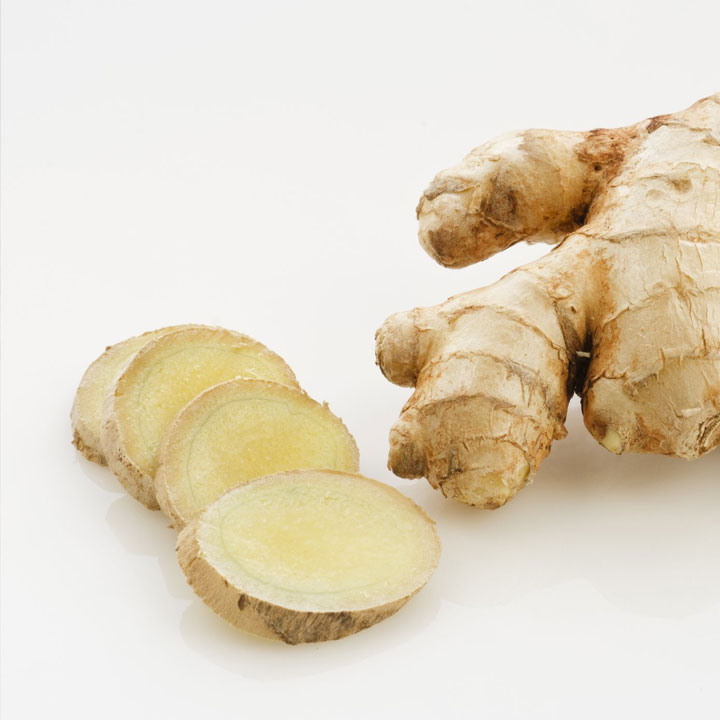
Image Source: https://now.tufts.edu/
Ginger (Zingiber officinale) is a plant belonging to the Zingiberaceae family, and its rhizomes are used in various forms in food and traditional medicine due to its anti-inflammatory, antioxidant, anti-apoptotic, antiviral and antibacterial effects. About 400 different components such as carbohydrates, lipids, terpenes and phenolics have been identified in ginger. These compounds were divided into phenols and aromatics: gingerols, shogaols, zingerones, gingerdiones, paradols, zerumbones and capsaicin belong to phenolic compounds and are astringent, while pinene, borneol, cumene, camphene, zingiberol and bisabolene are classified as aromatics. Among the biologically active terpene compounds, gingerols are the most abundant.
Ginger extract has an antioxidant effect, in vitro increasing the concentration of superoxide dismutase (SOD), glutathione peroxidase (GPx) and catalase (CAT) and contributing to the elimination of accumulated free radicals (superoxide radicals and hydrogen peroxide).
Ginger is credited as an anti-inflammatory agent by inhibiting cyclooxygenase-2 (COX-2) and decreasing the production of inflammatory factors, TNF-α and IL-β.
Ginger extract exhibits an antiacetylcholinesterase, muscarinic and calcium channel antagonist activity, effects with a role in cholinergic potentiation and neuroprotection.
Ginsenosides Rg1, Rb1, Rg3, and Rh2 have been shown to be effective in enhancing learning and improving memory, inhibiting apoptosis, and protecting neurons from neurotoxic insults. Ginsenosides Rg3 and Rh2 are effective in protecting the central nervous system, preventing neurodegenerative diseases, and may also be useful in the treatment of Alzheimer’s disease.
Studies have shown that ginger has a modulating effect on body weight and lowers serum glucose and blood lipids, with chronic consumption reducing the risk of cardiovascular disease and diabetes.
Bibliography
- Secades JJ, Gareri P. Citicoline: pharmacological and clinical review, 2022 update. Rev Neurol. 2022 Nov 30;75(s05):S1-S89. English, Spanish. doi: 10.33588/rn.75s05.2022311. PMID: 36544369.
Synoradzki K, Grieb P. Citicoline: A superior form of choline? Nutrients (2019)11:1569.
Jasielski P, Piedel F, Piwek M, Rocka A, Petit V, Rejdak K. Application of citicoline în neurological disorders: A systematic review. Nutrients (2020) 12:3113.
Marti-Carvajal AJ, Valli C, Marti-Amarista CE, Sola I, Marti-Fabregas J, Bonfill Cosp X. Citicoline for treating people with acute ischemic stroke. Cochrane Database Syst Rev (2020) 8:CD013066.
Que DS, Jamora RDG. Citicoline as adjuvant therapy în Parkinson’s disease: A systematic review. Clin Ther (2021) 43:e19–31.
Grieb P. Neuroprotective properties of citicoline: facts, doubts and unresolved issues. CNS Drugs. 2014 Mar;28(3):185-93.
Roy P, Tomassoni D, Nittari G, Traini E, Amenta F. Effects of choline containing phospholipids on the neurovascular unit: A review. Front Cell Neurosci. 2022 Sep 23;16:988759.
Marcucci H., Paoletti L., Jackowski S., Banchio C. (2010). Phosphatidylcholine biosynthesis during neuronal differentiation and its role în cell fate determination. J. Biol. Chem. 285 25382–25393. 10.1074/jbc.M110.139477.
Ridgway D. N. (2021). “Phospholipid synthesis în mammalian cells,” în Biochemistry of lipids, lipoproteins and membranes, 7th Edn, Vol. 7 eds Ridgway N., McLeod R. 227–258.
Ylilauri M. P. T., Voutilainen S., Lönnroos E., Virtanen H. E. K., Tuomainen T. P., Salonen J. T., et al. (2019). Associations of dietary choline intake with risk of incident dementia and with cognitive performance: The Kuopio ischaemic heart disease risk factor study. Am. J. Clin. Nutr. 110 1416–1423. 10.1093/ajcn/nqz148.
Muma N. A., Rowell P. P. (1988). Effects of chronic choline and lecithin on mouse hippocampal dendritic spine density. Exp. Aging Res. 14 137–141. 10.1080/03610738808259738.
Maier J.A., Castiglioni S., Locatelli L., Zocchi M., Mazur A. Magnesium and inflammation: Advances and perspectives. Semin. Cell Dev. Biol. 2021;115:37–44.
Tsuji R., Inoue H., Uehara M., Kida S. Dietary magnesium deficiency induces the expression of neuroinflammation-related genes în mouse brain. Neuropsychopharmacol. Rep. 2021;41:230–236.
Kirkland AE, Sarlo GL, Holton KF. The Role of Magnesium în Neurological Disorders. Nutrients. 2018 Jun 6;10(6):730. doi: 10.3390/nu10060730. PMID: 29882776; PMCID: PMC6024559.
Silberstein SD. Preventive Migraine Treatment. Continuum (Minneap Minn). 2015 Aug;21(4 Headache):973-89.
Stach K, Stach W, Augoff K. Vitamin B6 în Health and Disease. Nutrients. 2021 Sep 17;13(9):3229. doi: 10.3390/nu13093229.
Hellmann H, Mooney S. Vitamin B6: a molecule for human health? Molecules. 2010 Jan 20;15(1):442-59.
Parra M, Stahl S, Hellmann H. Vitamin B₆ and Its Role în Cell Metabolism and Physiology. Cells. 2018 Jul 22;7(7):84.
Ueland PM, Ulvik A, Rios-Avila L, Midttun Ø, Gregory JF. Direct and Functional Biomarkers of Vitamin B6 Status. Annu Rev Nutr. 2015;35:33-70.
Sharif S, Guirguis A, Fergus S, Schifano F. The Use and Impact of Cognitive Enhancers among University Students: A Systematic Review. Brain Sci. 2021 Mar 10;11(3):355.
Pu WL, Zhang MY, Bai RY, Sun LK, Li WH, Yu YL, Zhang Y, Song L, Wang ZX, Peng YF, Shi H, Zhou K, Li TX. Anti-inflammatory effects of Rhodiola rosea L.: A review. Biomed Pharmacother. 2020 Jan;121:109552.
Chen Y, Tang M, Yuan S, Fu S, Li Y, Li Y, Wang Q, Cao Y, Liu L, Zhang Q. Rhodiola rosea: A Therapeutic Candidate on Cardiovascular Diseases. Oxid Med Cell Longev. 2022 Feb 27;2022:1348795.
Li Y, Cai M, Mao GX, Shu QF, Liu XB, Liu XL. Preclinical Evidence and Possible Mechanisms of Rhodiola rosea L. and Its Components for Ischemic Stroke: A Systematic Review and Meta-Analysis. Front Pharmacol. 2021 Nov 5;12:736198.
Limanaqi F, Biagioni F, Busceti CL, Polzella M, Fabrizi C, Fornai F. Potential Antidepressant Effects of Scutellaria baicalensis, Hericium erinaceus and Rhodiola rosea. Antioxidants (Basel). 2020 Mar 12;9(3):234.
Ishaque S, Shamseer L, Bukutu C, Vohra S. Rhodiola rosea for physical and mental fatigue: a systematic review. BMC Complement Altern Med. 2012 May 29;12:70. doi: 10.1186/1472-6882-12-70.
Panossian A, Wikman G, Sarris J. Rosenroot (Rhodiola rosea): traditional use, chemical composition, pharmacology and clinical efficacy. Phytomedicine. 2010 Jun;17(7):481-93.
- Fijałkowska A, Jędrejko K, Sułkowska-Ziaja K, Ziaja M, Kała K, Muszyńska B. Edible Mushrooms as a Potential Component of Dietary Interventions for Major Depressive Disorder. Foods. 2022 May 20;11(10):1489.
- Rai SN, Mishra D, Singh P, Vamanu E, Singh MP. Therapeutic applications of mushrooms and their biomolecules along with a glimpse of în silico approach în neurodegenerative diseases. Biomed Pharmacother. 2021 May;137:111377.
Li IC, Lee LY, Tzeng TT, Chen WP, Chen YP, Shiao YJ, Chen CC. Neurohealth Properties of Hericium erinaceus Mycelia Enriched with Erinacines. Behav Neurol. 2018 May 21;2018:5802634.
Chong PS, Fung ML, Wong KH, Lim LW. Therapeutic Potential of Hericium erinaceus for Depressive Disorder. Int J Mol Sci. 2019 Dec 25;21(1):163.
Sabaratnam V, Kah-Hui W, Naidu M, Rosie David P. Neuronal health – can culinary and medicinal mushrooms help? J Tradit Complement Med. 2013 Jan;3(1):62-8.
Sekhar VC, Viswanathan G, Baby S. Insights Into the Molecular Aspects of Neuroprotective Bacoside A and Bacopaside I. Curr Neuropharmacol. 2019;17(5):438-446.
Fatima U, Roy S, Ahmad S, Ali S, Elkady WM, Khan I, Alsaffar RM, Adnan M, Islam A, Hassan MI. Pharmacological attributes of Bacopa monnieri extract: Current updates and clinical manifestation. Front Nutr. 2022 Aug 18;9:972379.
Simpson T, Pase M, Stough C. Bacopa monnieri as an Antioxidant Therapy to Reduce Oxidative Stress în the Aging Brain. Evid Based Complement Alternat Med. 2015;2015:615384. doi: 10.1155/2015/615384. Epub 2015 Aug 27.
Aguiar S, Borowski T. Neuropharmacological review of the nootropic herb Bacopa monnieri. Rejuvenation Res. 2013 Aug;16(4):313-26. doi: 10.1089/rej.2013.1431.
Abdul Manap AS, Vijayabalan S, Madhavan P, Chia YY, Arya A, Wong EH, Rizwan F, Bindal U, Koshy S. Bacopa monnieri, a Neuroprotective Lead în Alzheimer Disease: A Review on Its Properties, Mechanisms of Action, and Preclinical and Clinical Studies. Drug Target Insights. 2019 Jul 31;13:1177392819866412.
Anas Sohail A, Ortiz F, Varghese T, Fabara SP, Batth AS, Sandesara DP, Sabir A, Khurana M, Datta S, Patel UK. The Cognitive-Enhancing Outcomes of Caffeine and L-theanine: A Systematic Review. Cureus. 2021 Dec 30;13(12):e20828.
Paiva L, Lima E, Motta M, Marcone M, Baptista J. Variability of antioxidant properties, catechins, caffeine, L-theanine and other amino acids în different plant parts of Azorean Camellia sinensis. Curr Res Food Sci. 2020 Aug 15;3:227-234.
Rothenberg DO, Zhang L. Mechanisms Underlying the Anti-Depressive Effects of Regular Tea Consumption. Nutrients. 2019 Jun 17;11(6):1361.
Akbarialiabad H, Dahroud MD, Khazaei MM, Razmeh S, Zarshenas MM. Green Tea, A Medicinal Food with Promising Neurological Benefits. Curr Neuropharmacol. 2021;19(3):349-359.
Li MY, Liu HY, Wu DT, Kenaan A, Geng F, Li HB, Gunaratne A, Li H, Gan RY. L-Theanine: A Unique Functional Amino Acid în Tea (Camellia sinensis L.) With Multiple Health Benefits and Food Applications. Front Nutr. 2022 Apr 4;9:853846.
